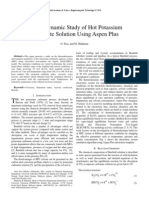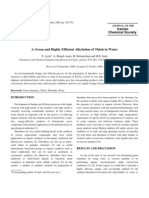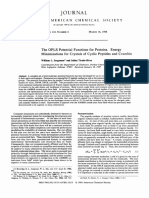Acetylacetone
Acetylacetone
Uploaded by
ac_76_pxCopyright:
Available Formats
Acetylacetone
Acetylacetone
Uploaded by
ac_76_pxCopyright
Available Formats
Share this document
Did you find this document useful?
Is this content inappropriate?
Copyright:
Available Formats
Acetylacetone
Acetylacetone
Uploaded by
ac_76_pxCopyright:
Available Formats
Acetylacetone
Acetylacetone
Acac redirects here. For other uses, see ACAC.
Acetylacetone
Identifiers CAS number ChemSpider UNII KEGG ChEBI ChEMBL Jmol-3D images 123-54-6 29001
[2] [1] [3]
46R950BP4J C15499
[4]
CHEBI:14750
[5]
[6]
CHEMBL191625 Image 1 [8] Image 2 Properties
[7]
Molecular formula Molar mass Density Melting point Boiling point Solubility in water
C5H8O2 100.13 g/mol 0.98 g/mL 23 C 140 C 16 g/100 mL Hazards
EU Index EU classification R-phrases S-phrases NFPA 704 Flash point Autoignition temperature Explosive limits
606-029-00-0 Harmful (Xn) R10, R22 (S2), S21, S23, S24/25
34 C 340 C 2.411.6%
Acetylacetone
2
[9]
(what is: / ?) Except where noted otherwise, data are given for materials in their standard state (at 25C, 100kPa)
(verify)
Infobox references
Acetylacetone is an organic compound that famously exists in two tautomeric forms that rapidly interconvert. The less stable tautomer is a diketone formally named pentane-2,4-dione. The more common tautomer is the enol form. The pair of tautomers rapidly interconvert and are treated as a single compound in most applications. It is a colourless liquid that is a precursor to acetylacetonate (acac), a common bidentate ligand. It is also a building block for the synthesis of heterocyclic compounds.
Properties
Solvent Gas Phase Kketo-enol 11.7
Cyclohexane 42 Toluene THF DMSO Water 10 7.2 2 0.23
The keto and enol forms of acetylacetone coexist in solution; these forms are tautomers. The C2v symmetry for the enol form displayed on the left in Scheme 1 has been verified by many methods, most prominently being NMR spectroscopy and IR spectroscopy.[10] In the gas phase, the equilibrium constant, Kketo-enol is 11.7, favoring the enol form.[11] The equilibrium constant tends to remain high in nonpolar solvents; the keto form becomes more favorable in polar, hydrogen-bonding solvents, such as water.[12] The enol form is a vinylogous analogue of a carboxylic acid.
Scheme 1. Tautomerism of 2,4-pentanedione
Acid-base properties
Acetylacetone is a weak acid: C5H8O2 C5H7O2 + H+
IUPAC recommended pKa values for this equilibrium in aqueous solution at 25 C are 8.990.04 (I = 0), 8.830.02 (I = 0.1 M NaClO4) and 9.000.03 (I=1.0 M NaClO4) (I=Ionic strength).[13] Values for mixed solvents are available. Very strong bases, such as organolithium compounds, will deprotonate acetylacetone twice. The resulting dilithio species can then be alkylated at C-1.
Acetylacetone
solvent
T/C pK [14] a 9.8 12.5 10.16 13.41
40% ethanol/water 30 70% dioxane/water 28 80% DMSO/water DMSO 25 25
Preparation
Acetylacetone is prepared industrially by the thermal rearrangement of isopropenylacetate.[15] CH2(CH3)COC(O)Me MeC(O)CH2C(O)Me Laboratory routes to acetylacetone begin also with acetone. Acetone and acetic anhydride upon the addition of BF3 catalyst:[16] (CH3CO)2O + CH3C(O)CH3 CH3C(O)CH2C(O)CH3 A second synthesis involves the base-catalyzed condensation of acetone and ethyl acetate, followed by acidification:[16] NaOEt + EtO2CCH3 + CH3C(O)CH3 NaCH3C(O)CHC(O)CH3 + 2 EtOH NaCH3C(O)CHC(O)CH3 + HCl CH3C(O)CH2C(O)CH3 + NaCl Because of the ease of these syntheses, many analogues of acetylacetonates are known. Some examples include C6H5C(O)CH2C(O)C6H5 (dbaH) and (CH3)3CC(O)CH2C(O)CC(CH3)3. Hexafluoroacetylacetonate is also widely used to generate volatile metal complexes.
Reactions
Condensations
Acetylacetone is a versatile bifunctional precursor to heterocycles because both keto groups undergo condensation. Hydrazine reacts to produce pyrazoles. Urea gives pyrimidines. Condensation with aryl- and alkylamines to gives the mono- and then the didiketimines wherein the O atoms in acetylacetone are replaced by NR (R = aryl, alkyl).
Coordination chemistry
The acetylacetonate anion, acac-, forms complexes with many transition metal ions. A general method of synthesis is to react the metal ion with acetylacetone in the presence of a base (B): Mz+ + z (acacH) M(acac)z +z BH+
which assists the removal of a proton from acetylacetone and shifts the equilibrium in favour of the complex. Both oxygen atoms bind to the metal to form a six-membered chelate ring. In some cases the chelate effect is so strong that no added base is needed to form the complex. Since the metal complex carries no electrical charge, it is soluble in non-polar organic solvents.
A ball-and-stick model of VO(acac)2
Acetylacetone
Biodegradation
Enzymatic breakdown: The enzyme acetylacetone dioxygenase cleaves the carbon-carbon bond of acetyacetone, producing acetate and 2-oxopropanal. The enzyme is Fe(II)-dependent, but it has been proven to bind to zinc as well. Acetylacetone degradation has been characterized in the bacterium Acinetobacter johnsonii.[17] C5H8O2 + O2 C2H4O2 + C3H4O2
References
[1] [2] [3] [4] [5] [6] [7] [8] [9] http:/ / www. commonchemistry. org/ ChemicalDetail. aspx?ref=123-54-6 http:/ / www. chemspider. com/ 29001 http:/ / fdasis. nlm. nih. gov/ srs/ srsdirect. jsp?regno=46R950BP4J http:/ / www. kegg. jp/ entry/ C15499 https:/ / www. ebi. ac. uk/ chebi/ searchId. do?chebiId=14750 https:/ / www. ebi. ac. uk/ chembldb/ index. php/ compound/ inspect/ CHEMBL191625 http:/ / chemapps. stolaf. edu/ jmol/ jmol. php?model=O%3DC%28C%29CC%28%3DO%29C http:/ / chemapps. stolaf. edu/ jmol/ jmol. php?model=CC%28%3DO%29CC%28%3DO%29C http:/ / en. wikipedia. org/ wiki/ Special%3Acomparepages?rev1=443366220& page2=%3AAcetylacetone
[10] Kimberly A. Manbeck, Nicholas C. Boaz, Nathaniel C. Bair, Allix M. S. Sanders, and Anderson L. Marsh (2011). "Substituent Effects on Keto-Enol Equilibria Using NMR Spectroscopy". Journal of Chemical Education 88 (10): 14441445. doi:10.1021/ed1010932.. Z. Yoshida, H. Ogoshi, T. Tokumitsu "Intramolecular hydrogen bond in enol form of 3-substituted-2,4-pentanedione" Tetrahedron 1970, volume 26, pp. 5691-5697. doi:10.1016/0040-4020(70)80005-9 [11] W. Caminati, J.-U. Grabow (2006). "The C2v Structure of Enolic Acetylacetone". Journal of the American Chemical Society 128 (3): 854857. doi:10.1021/ja055333g. PMID16417375. [12] Solvents and Solvent Effects in Organic Chemistry, Christian Reichardt Wiley-VCH; 3 edition 2003 ISBN 3-527-30618-8 [13] Stary, J.; Liljenzin, J.O. (1982). "Critical evaluation of equilibrium constants involving acetylacetone and its metal chelates" (http:/ / www. iupac. org/ publications/ pac/ pdf/ 1982/ pdf/ 5412x2557. pdf). Pure and Applied Chemistry 54 (12): 25572592. doi:10.1351/pac198254122557. . [14] IUPAC SC-Database (http:/ / www. acadsoft. co. uk/ scdbase/ scdbase. htm) A comprehensive database of published data on equilibrium constants of metal complexes and ligands [15] Hardo Siegel, Manfred Eggersdorfer Ketones in Ullmanns Encyclopedia of Industrial Chemistry, Wiley-VCH, 2002, Wienheim. doi:10.1002/14356007.a15_077 [16] C. E. Denoon, Jr., "Acetylacetone" (http:/ / www. orgsyn. org/ orgsyn/ orgsyn/ prepContent. asp?prep=cv3p0016), Org. Synth., ; Coll. Vol. 3: 16 [17] Straganz, G.D.; Glieder, A.; Brecker, L.; Ribbons, D.W.; Steiner, W. (2003). "Acetylacetone-cleaving enzyme Dke1: a novel C-C-bond-cleaving enzyme from Acinetobacter johnsonii". Biochem. J. 369 (Pt 3): 573581. doi:10.1042/BJ20021047. PMC1223103. PMID12379146.
External links
International Chemical Safety Card 0533 (http://www.inchem.org/documents/icsc/icsc/eics0533.htm)
Article Sources and Contributors
Article Sources and Contributors
Acetylacetone Source: http://en.wikipedia.org/w/index.php?oldid=484038500 Contributors: Aegis Maelstrom, Astrochemist, Beetstra, Benjah-bmm27, Betacommand, Breakyunit, Chem-awb, Chem221, ChemicalBit, Chiu frederick, Christian75, Confiteordeo, Cwhaley, Drbreznjev, Drpagel, Dycedarg, Edgar181, Eugene-elgato, Galoubet, Grimlock, H Padleckas, Headbomb, Herbee, J. Atkinson, Japanese Searobin, Jimz0r, John of Reading, Juliancolton, Jynto, Lkinkade, Mr0t1633, Naffer, Nick Number, Petergans, Physchim62, Puppy8800, Rifleman 82, Rjwilmsi, Robertvan1, Shalom Yechiel, Silverchemist, SimonP, Smokefoot, Stone, The Other Guy, V8rik, Vijaykumarutkam, Vuo, WVhybrid, Walkerma, 35 , anonymous edits
Image Sources, Licenses and Contributors
Image:Acetyloaceton.svg Source: http://en.wikipedia.org/w/index.php?title=File:Acetyloaceton.svg License: Public Domain Contributors: Arrowsmaster File:Acetylacetone-enol-3D-balls.png Source: http://en.wikipedia.org/w/index.php?title=File:Acetylacetone-enol-3D-balls.png License: Public Domain Contributors: Benjah-bmm27 File:Acetylacetone-keto-3D-balls.png Source: http://en.wikipedia.org/w/index.php?title=File:Acetylacetone-keto-3D-balls.png License: Public Domain Contributors: Benjah-bmm27 File:Yes check.svg Source: http://en.wikipedia.org/w/index.php?title=File:Yes_check.svg License: Public Domain Contributors: Anomie Image:X mark.svg Source: http://en.wikipedia.org/w/index.php?title=File:X_mark.svg License: Public Domain Contributors: User:Gmaxwell Image:AcacH.png Source: http://en.wikipedia.org/w/index.php?title=File:AcacH.png License: Public Domain Contributors: Smokefoot Image:Equilibrium.svg Source: http://en.wikipedia.org/w/index.php?title=File:Equilibrium.svg License: Public Domain Contributors: L'Aquatique Image:Vanadyl-acetoacetonate-3D-balls.png Source: http://en.wikipedia.org/w/index.php?title=File:Vanadyl-acetoacetonate-3D-balls.png License: Public Domain Contributors: Benjah-bmm27
License
Creative Commons Attribution-Share Alike 3.0 Unported //creativecommons.org/licenses/by-sa/3.0/
You might also like
- Potassium Carbonate Using AspenplusDocument5 pagesPotassium Carbonate Using AspenpluspancokomNo ratings yet
- Application Performance Management For Microservice Applications On Kubernetes The UltimateDocument24 pagesApplication Performance Management For Microservice Applications On Kubernetes The UltimateankitnayanNo ratings yet
- Hai5 2019 J.coord - ChemDocument17 pagesHai5 2019 J.coord - ChemToshiro KiyoshiNo ratings yet
- Heterogeneous Asymmetric Diels-Alder Reactions Using A Copper-Chiral Bis (Oxazoline) Complex Immobilized On Mesoporous SilicaDocument5 pagesHeterogeneous Asymmetric Diels-Alder Reactions Using A Copper-Chiral Bis (Oxazoline) Complex Immobilized On Mesoporous SilicaJC Jane BarnesNo ratings yet
- Acetoacetic Acid - Diketene React With AmineDocument3 pagesAcetoacetic Acid - Diketene React With AmineLaila Ambar SariNo ratings yet
- AcetonitrileDocument7 pagesAcetonitriletechzonesNo ratings yet
- C 2 SC 21163 GDocument12 pagesC 2 SC 21163 GSumanta PadhiNo ratings yet
- X-Ray Diffraction, Solution Structure, and Computational Studies On Derivatives of (3-sec-Butyl-2,3-dihydro-1H-isoquinolin-4-ylidene) Acetic Acid: Compounds With Activity As Calpain InhibitorsDocument11 pagesX-Ray Diffraction, Solution Structure, and Computational Studies On Derivatives of (3-sec-Butyl-2,3-dihydro-1H-isoquinolin-4-ylidene) Acetic Acid: Compounds With Activity As Calpain InhibitorsSilvanaMedhatNo ratings yet
- 1a PublicacionDocument11 pages1a PublicacionRoly RcmNo ratings yet
- Journal of Molecular StructureDocument6 pagesJournal of Molecular StructureRia YuliaNo ratings yet
- MS 204Document4 pagesMS 204Suyog patilNo ratings yet
- Review About MonoethanolamineDocument59 pagesReview About MonoethanolaminebexigaobrotherNo ratings yet
- Djokic JCS Perkin Trans.1 1986 Pp1881Document10 pagesDjokic JCS Perkin Trans.1 1986 Pp1881Mario Micciarelli100% (1)
- 1,2 Benzoquinone WikipediaDocument5 pages1,2 Benzoquinone WikipediaBilal Akbar YaseeniNo ratings yet
- DdddadassDocument15 pagesDdddadassSoloproNo ratings yet
- SsaaDocument19 pagesSsaaSoloproNo ratings yet
- 12 Ane Metal Ion ComplexesDocument9 pages12 Ane Metal Ion ComplexesSabrina MilanoNo ratings yet
- Ursolic 3Document8 pagesUrsolic 3Byn TranNo ratings yet
- Effects of Operating Conditions On Improving Alkali and Electrical Efficiency in Chlor-Alkali Diaphragm CellDocument10 pagesEffects of Operating Conditions On Improving Alkali and Electrical Efficiency in Chlor-Alkali Diaphragm Cellnikhilsingh1087No ratings yet
- Ensayo ElectroquimicaDocument7 pagesEnsayo ElectroquimicaMarisol GómezNo ratings yet
- Synthesis of Simple (E) - 2 - (2-Nitrobut-2-Enyloxy) Benzaldehyde Derivatives From (E) - (3-Chloro-2 - Nitroprop-1-Enyl) BenzeneDocument6 pagesSynthesis of Simple (E) - 2 - (2-Nitrobut-2-Enyloxy) Benzaldehyde Derivatives From (E) - (3-Chloro-2 - Nitroprop-1-Enyl) BenzeneIAEME PublicationNo ratings yet
- H. Catherine W. Skinner2 Haven, Connecticut 06510 and John Nalbandian Professor Ofperiodontics, School Ofdental MedicineDocument21 pagesH. Catherine W. Skinner2 Haven, Connecticut 06510 and John Nalbandian Professor Ofperiodontics, School Ofdental MedicinePHiephien Ituh PhiphienNo ratings yet
- Drugs of The Future 2002, 27 (2) 143-158Document16 pagesDrugs of The Future 2002, 27 (2) 143-158Rajesh TammanaNo ratings yet
- Apr 2011 2 4 104 107 PDFDocument4 pagesApr 2011 2 4 104 107 PDFDavid GonzalezNo ratings yet
- Synthesis and Regiochemistry of (60) Fullerenyl 2-Methylmalonate Bisadducts and Their Facile Electron-Accepting PropertiesDocument10 pagesSynthesis and Regiochemistry of (60) Fullerenyl 2-Methylmalonate Bisadducts and Their Facile Electron-Accepting PropertiesDiogo DiasNo ratings yet
- Chemistry Olympiad 2010 PaperDocument11 pagesChemistry Olympiad 2010 PaperAlokShuklaNo ratings yet
- Hydrothermal Synthesis of Catena (Triaqua - (U-2-croconato-O, O',O",O'") - Calcium (II) ) Calcium Croconate TrihydrateDocument4 pagesHydrothermal Synthesis of Catena (Triaqua - (U-2-croconato-O, O',O",O'") - Calcium (II) ) Calcium Croconate TrihydratebetimquimicaNo ratings yet
- Effectiveness of Some Organic Compounds As Corrosion Inhibitors For Stainless Steel 201 in 1M HCL: Experimental and Theoretical StudiesDocument21 pagesEffectiveness of Some Organic Compounds As Corrosion Inhibitors For Stainless Steel 201 in 1M HCL: Experimental and Theoretical Studiesalaa.ibrahim.868686No ratings yet
- Copper - Anticancer - DPA Deriv - B - Art:10.1007/s11243-009-9200-5Document9 pagesCopper - Anticancer - DPA Deriv - B - Art:10.1007/s11243-009-9200-5skattejagNo ratings yet
- Synthesis, Characterization and Thermal Properties of Sodium Pyruvate Thiosemicarbazone and Some of Its Metal ComplexesDocument7 pagesSynthesis, Characterization and Thermal Properties of Sodium Pyruvate Thiosemicarbazone and Some of Its Metal ComplexesDaciana CrisanNo ratings yet
- Chlorination of Alcohols by Pivaloyl Chloride-DMFDocument3 pagesChlorination of Alcohols by Pivaloyl Chloride-DMFalchymystNo ratings yet
- Photocatalytic Oxidation of Acetic Acid Overcds: Suresh C. Ameta and Chetna GomberDocument3 pagesPhotocatalytic Oxidation of Acetic Acid Overcds: Suresh C. Ameta and Chetna GomberInternational Organization of Scientific Research (IOSR)No ratings yet
- (Grupo 3) Photocatalyzed Direct Α-Alkylation of Esters Using Styrenes Adv Synth Catal - 2023 - WangDocument6 pages(Grupo 3) Photocatalyzed Direct Α-Alkylation of Esters Using Styrenes Adv Synth Catal - 2023 - Wangjuan.ceballos.anayaNo ratings yet
- Grunwald The Correlation of Solvolysis RatesDocument9 pagesGrunwald The Correlation of Solvolysis RatesZach SmithNo ratings yet
- Thiols Formation in Presence of K2co3Document5 pagesThiols Formation in Presence of K2co3Harjinder Singh BhatiaNo ratings yet
- Bio Org Chem Lett 2008Document4 pagesBio Org Chem Lett 2008Suman BalyaniNo ratings yet
- H2 Chemistry Mock A Level Paper 3Document12 pagesH2 Chemistry Mock A Level Paper 3Liu RuoyangNo ratings yet
- SAMPLE PAPER-02 (Solved) Class - XII AnswersDocument7 pagesSAMPLE PAPER-02 (Solved) Class - XII AnswerskeerthyNo ratings yet
- The Structure of New Host Molecules That Form Channel Inclusion CompoundsDocument5 pagesThe Structure of New Host Molecules That Form Channel Inclusion CompoundsmeltastNo ratings yet
- Lanthanum Tricyanide-Catalyzed Acyl Silane - Ketone Benzoin Additions and Kinetic Resolution of Resultant R-SilyloxyketonesDocument9 pagesLanthanum Tricyanide-Catalyzed Acyl Silane - Ketone Benzoin Additions and Kinetic Resolution of Resultant R-SilyloxyketonesDiogo DiasNo ratings yet
- Manuscript DraftDocument20 pagesManuscript DraftsadaNo ratings yet
- ANTHONY CRASTO-Brevetoxin SynthesisDocument58 pagesANTHONY CRASTO-Brevetoxin SynthesisAnthony Melvin Crasto Ph.DNo ratings yet
- Efficient Cyanoaromatic Photosensitizers For Singlet Oxygen Production: Synthesis and Characterization of The Transient Reactive SpeciesDocument21 pagesEfficient Cyanoaromatic Photosensitizers For Singlet Oxygen Production: Synthesis and Characterization of The Transient Reactive SpeciesemmanuNo ratings yet
- 1 Opls Aa Force Field PDFDocument10 pages1 Opls Aa Force Field PDFLucas PalmeiraNo ratings yet
- (E) - Methyl 3 - (10-Bromoanthracen-9-Yl) - AcrylateDocument9 pages(E) - Methyl 3 - (10-Bromoanthracen-9-Yl) - AcrylateYosefAl-JasemNo ratings yet
- Treatment of Cattle-Slaughterhouse Wastewater Using Tubular ElectrocoagulatorDocument4 pagesTreatment of Cattle-Slaughterhouse Wastewater Using Tubular Electrocoagulatorrose2401No ratings yet
- Alkaloids Extract From Palicourea Guianensis Plant As Corrosion Inhibitor For C38 Steel in 1 M Hydrochloric Acid MediumDocument13 pagesAlkaloids Extract From Palicourea Guianensis Plant As Corrosion Inhibitor For C38 Steel in 1 M Hydrochloric Acid Mediumfitrah fajrianiNo ratings yet
- Crystals: Open AccessDocument9 pagesCrystals: Open AccessFarhanAkramNo ratings yet
- Journal of Molecular StructureDocument7 pagesJournal of Molecular StructureindahNo ratings yet
- A Fluorogenic Click' Reaction of Azidoanthracene DerivativesDocument9 pagesA Fluorogenic Click' Reaction of Azidoanthracene DerivativeskawtherahmedNo ratings yet
- 9780199277896Document40 pages9780199277896Timmavajjula Venkata KarthikNo ratings yet
- 2016 Sample Paper 12 Chemistry 02 AnsDocument7 pages2016 Sample Paper 12 Chemistry 02 AnsjrajaNo ratings yet
- 1 s2.0 S0927775712007303 MainDocument12 pages1 s2.0 S0927775712007303 MainJôsy SouzaNo ratings yet
- A Simple and Straightforward Approach To Quinoxalines by Iron/Sulfur-Catalyzed Redox Condensation of o Nitroanilines and PhenethylaminesDocument4 pagesA Simple and Straightforward Approach To Quinoxalines by Iron/Sulfur-Catalyzed Redox Condensation of o Nitroanilines and PhenethylaminesClaudia BocanegraNo ratings yet
- Ravi Sir 4thDocument4 pagesRavi Sir 4thPUTTUPU MANINo ratings yet
- Copper (I) Sulfide - WikipediaDocument13 pagesCopper (I) Sulfide - WikipediaChad IrungNo ratings yet
- Physicochemical Studies and Anticancer Potency of Ruthenium η - p-Cymene Complexes Containing Antibacterial QuinolonesDocument7 pagesPhysicochemical Studies and Anticancer Potency of Ruthenium η - p-Cymene Complexes Containing Antibacterial Quinolonesjafs190594No ratings yet
- Cephalosporin Antibiotics As New CorrosiDocument18 pagesCephalosporin Antibiotics As New Corrosichérifa boulechfarNo ratings yet
- 22Document5 pages22AndresCuevasDiazNo ratings yet
- Tetrahedron LettersDocument4 pagesTetrahedron LettersNGsalunkheNo ratings yet
- Chemoselective and Bioorthogonal Ligation Reactions: Concepts and ApplicationsFrom EverandChemoselective and Bioorthogonal Ligation Reactions: Concepts and ApplicationsW. Russ AlgarNo ratings yet
- Sheet 1Document3 pagesSheet 1bipico9217No ratings yet
- Clay Minerals and Engineering New (1) - Read-Only-1Document28 pagesClay Minerals and Engineering New (1) - Read-Only-1Lebohang SheaneNo ratings yet
- 15047/purbanchal Exp Sleeper Class (SL) : WL WLDocument2 pages15047/purbanchal Exp Sleeper Class (SL) : WL WLDeepak PathakNo ratings yet
- The Ancestral Indigenous Diet A Whole Foods Meat-Based Carnivore Diet (Frank Tufano) (Z-Library)Document76 pagesThe Ancestral Indigenous Diet A Whole Foods Meat-Based Carnivore Diet (Frank Tufano) (Z-Library)stewpitt2No ratings yet
- Chapter 3: Research Methodology: 1.2.1 Type of StudyDocument8 pagesChapter 3: Research Methodology: 1.2.1 Type of StudyluminyiNo ratings yet
- 6. 화공계산 연습문제2장-과제Document24 pages6. 화공계산 연습문제2장-과제xkrdmlcksNo ratings yet
- Sepr 1 SRSDocument2 pagesSepr 1 SRSVikrant ShimikeriNo ratings yet
- 33 FDPRHTEQnewDocument2 pages33 FDPRHTEQnewbalrambalram2403No ratings yet
- Primary - Sekolah Cikal Surabaya - Enrollment Guide 2024-2025 3Document15 pagesPrimary - Sekolah Cikal Surabaya - Enrollment Guide 2024-2025 3Naura Athiyyah SativaNo ratings yet
- 5 Essential PatDocument4 pages5 Essential PatMichael RotimiNo ratings yet
- Check Valves 50 Series (MS-01-98) R4Document2 pagesCheck Valves 50 Series (MS-01-98) R4herysyam1980No ratings yet
- Golf Course Stat Tracking WorksheetsDocument9 pagesGolf Course Stat Tracking WorksheetsSarah Jane SaidiNo ratings yet
- 9.d. Isoquants:: F (K, L) QDocument2 pages9.d. Isoquants:: F (K, L) QMuhammad Fajar Agna FernandyNo ratings yet
- Coach Record v2024Document1 pageCoach Record v2024marcsil DalumpinesNo ratings yet
- Accomplishment Report Overtime RevisitDocument3 pagesAccomplishment Report Overtime RevisitJERYL MAY CRUDONo ratings yet
- Wyn032 PDFDocument21 pagesWyn032 PDFWahjudi MuhammadNo ratings yet
- Brochure - Wadhawa Wise CityDocument8 pagesBrochure - Wadhawa Wise Cityrahul badgujarNo ratings yet
- MIS Strategic Plan For Tesla MotorsDocument11 pagesMIS Strategic Plan For Tesla MotorsRintu Adhikary33% (3)
- Kingdoms Forlorn Story BookDocument36 pagesKingdoms Forlorn Story BookChrys MNo ratings yet
- Science 6 2019Document531 pagesScience 6 2019jocelyn q. cabrillasNo ratings yet
- BY Wankar Sir: Indian Railways Group A ServiceDocument14 pagesBY Wankar Sir: Indian Railways Group A Servicekshitij vaidyaNo ratings yet
- Entrep Chap 1Document16 pagesEntrep Chap 1Lyle Fatima CalagsingNo ratings yet
- Photosynthesis in ColorsDocument3 pagesPhotosynthesis in ColorsLorence VillaminNo ratings yet
- BK 2021Document11 pagesBK 2021rg3799290No ratings yet
- Interim 7 Consolidation AFAR1Document7 pagesInterim 7 Consolidation AFAR1Bea Tepace PototNo ratings yet
- CurrentDocument53 pagesCurrentNaresh GhaiNo ratings yet
- Heap Sort - Data Structures and Algorithms Tutorials - GeeksforGeeksDocument2 pagesHeap Sort - Data Structures and Algorithms Tutorials - GeeksforGeekslongphiycNo ratings yet
- Anritsu MT9090A-MU909020ADocument8 pagesAnritsu MT9090A-MU909020AHamdala AnNo ratings yet
- Kit Culatas PreciosDocument3 pagesKit Culatas PrecioskatheNo ratings yet

























































































